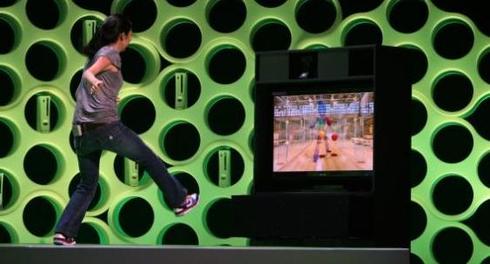This post has not been edited by the GamesBeat staff. Opinions by GamesBeat community writers do not necessarily reflect those of the staff.
Editor’s note: Nicholas says that motion controls won’t be a success until developers figure out a way to ditch the exaggerated gestures and movements for a more subtle approach. I was getting used to looking like a rodeo clown when I play my Wii. -Jason
The dual-analog-stick controller has remained the control standard in the industry
because of its comfort and functionality.
Control paradigms change and evolve over the course of time in the video game industry. The NES’s D-pad-and-button configuration was a change from previous controllers introduced by consoles such as Atari and Intellivision.
Over time, console makers added more buttons to controllers, and D-pads were replaced by analog sticks — until Sony introduced the DualShock dual-analog-stick controller over a decade ago. A strong, comfortable, and ergonomically sound device, the dual-analog-stick controller was the standard for video game controllers for more than a generation.
However, the time for change has arrived once more in the form of Nintendo’s Wii Remote, which introduces a new dimension to controllers: motion control. The widespread appeal of Nintendo’s innovative and market-disruptive controller has forced the competition to respond with motion-control schemes of their own.
Microsoft recently introduced Project Natal, a camera that promises to bring users even further into their games with the most familiar controller they’ve ever known: their own bodies. Sony responded with wand controllers for the PlayStation Eye, which appear similar to Nintendo’s Wii Remote yet possess somewhat different, if not added, functionality.
By the end of next year, there’ll likely be no shortage of motion controls or motion-controlled games.
The argument that console manufacturers make for motion controls is that they are simpler and more intuitive than existing controllers that utilize dual analog sticks. It’s a difficult argument to counter, as dual-analog-stick controllers are rather intimidating at first glance, especially for nongamers.
The only way to learn how to hold a dual-analog-stick controller is through practice. Motion is certainly on at least a few levels more intuitive than a dual-analog-stick controller. After all, motion is a universal concept to humans. As children we crawl until we learn to walk, and then we learn to run, and then we spend most of our lives in motion.
Motion isn’t just a gimmick to human beings; it’s something we utilize every day.
That said, though, motion controls don’t really seem to be making a terrific point about tearing down barriers. To clarify, motion controls certainly make it easier to understand games and how they function. If I’m a casual gamer, it’s easy to understand that if I shake a controller, my character performs a designated action.
However, they don’t necessarily make games easier to actually play. The appeal of Natal demos like Ricochet might be undeniable, but Ricochet is a perfect example of the problem that all three motion controllers have in common: There is far too much emphasis on literal movement and nowhere near enough focus on comfort and subtlety.

Games like Ricochet might be fun, but use of the full body limits playtime and comfort.
It was once said that the rule for designing a successful video game controller is that performing a simple controller action results in an extraordinary gameplay action. The dual-analog-stick controller follows the rule perfectly. Extraordinary action is only as far away as your next button press.
However, with motion controls, the rule seems to be that extraordinary controller action equals extraordinary gameplay action. Shaking and dramatic sweeping movements seem to make up the controls of more than a few motion-control games.
They don’t look comfortable or fun to play for long periods of time, a problem that provides motion controls an even more difficult barrier to break before they gain acceptance as the default method of video games controls.
One of the essential elements of the dual-analog-stick controller’s popularity — and one of its greatest strengths — is that it’s very easy and comfortable to use for long periods of time. The truth is, motion controls could share this strength as well, but they need developers to change their strategies and approaches to control methods.
The most important element in motion controls shouldn’t be literal enactments of gameplay. Gamers don’t care most about literal enactments of gameplay when it comes to controls; they care about comfort and accessibility.
The ideal user control method for motion-control games should be just as much of a mental background process as pushing an analog stick and a button at the same time. Or, to the very least, be as nonintrusive and comfortable as Super Mario Galaxy’s controls.
Mastering this control minimalism could be the measuring stick for motion-control success. Look at the iPhone and how simple it is to make touches and dashing motions to access nearly every function of the device.
Look at the Wii’s firmware and how easy it is to select a channel. Watch Microsoft’s Project Natal demonstration again and watch Kudo Tsunoda effortlessly breeze through the Xbox Dashboard. That is the level of simplicity and the degree of response that gamers would like to see from their controls.
If motion controls can offer this level of simplicity, they will have a far easier time combating the widespread influence of the dual-analog-stick controller.

You can navigate the Nintendo Wii’s firmware menu with effortless simplicity. Developers working with motion controls should pursue this level of simplicity and comfort.
However, the longer it takes developers to create the ideal simplistic user control methods for motion controls, the more credence that the dual analog stick controllers will gain. The countdown before gamers begin dismissing motion controls as transitional technology will not be long.
After all, gamers love to play video games for hours. The less comfortable it is for them to do this with motion control games, the less likely they are to play games featuring motion controls. Imagine if a game like Battlefield 1943 had motion controls that were uncomfortable to play for long periods of time.
How quickly do you think that 43 million online-kills milestone would’ve been achieved?
Shooters like Battlefield 1943 bring up an interesting point not only regarding comfort but precision as well. If the countdown regarding the wait for comfortable controls is short, then the countdown regarding precise controls is even shorter.
Gamers were promised 1-to-1 movement for motion controls, and that seems to have been demonstrated in some cases. But developers still must demonstrate it in the games yet to come. As mentioned earlier, it’s been over a decade since the introduction of the video game console dual-analog-stick controller.
Shooter fans still debate intensely over whether or not a keyboard and mouse is the more precise control method. This kind of debate will come to motion controls and how they measure up to existing control methods.
If motion controls can’t offer the same level of precision as existing methods, gamers will ask for dual-analog-stick-controller support in the same way that FPS fans ask for keyboard-and-mouse support.
Or, perhaps more appropriately, gamers will ask for dual-analog-stick controller support the same way that Wii fans ask for GameCube/Classic Controller support of certain titles. Project Natal could especially be prone to this because it’s controller-less.
If the controls of Natal don’t function as precisely as promised, frustration will set in faster, as it’s far easier to continue playing imprecise controls on a dual-analog-stick controller than it is to continually gesture at the screen only to not receive the desired result.
The key to developers getting motion controls right is to implement simple, comfortable controls that offer the same — if not greater — levels of responsiveness as dual-analog-stick controllers.
Right now, literal movements seem to hold plenty of appeal because video games have never been able to offer that level of response before, but that’s a novelty appeal at best.
Developers need to realize that the path to long-term motion-control success will be in the ability of motion controls to supersede the comfort and ease of existing controllers, not in exaggerated movements that limit playtime and user comfort.
Otherwise, the video game industry will wave goodbye to motion controls — dismissing them as an experiment during an industry transitional era — and the dual-analog-stick controller will be here for some time to come.
